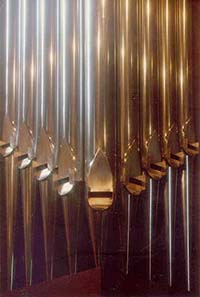Fowler Organ, Opus XVI
The Organ Builder's Perspective
 The
design and construction of any pipe organ presents its builder with a
number of challenges, both artistic and mechanical. The size of the
room, space available, placement constraints, room acoustics,
available funds, etc., all enter into the equation, often to the
detriment of the artistic.
The
design and construction of any pipe organ presents its builder with a
number of challenges, both artistic and mechanical. The size of the
room, space available, placement constraints, room acoustics,
available funds, etc., all enter into the equation, often to the
detriment of the artistic.
In this case we were presented with a modest sized room, adequate funding and the strong desire to create an artistically satisfying sound and a visually integrated installation. Consultation began with the concept of a basic "church organ" and grew as the months progressed into an instrument of considerable range and color. The only significant limitation proved to be the space available to house the mechanism, and that has been utilized to the absolute maximum.
The
tonal design is based on the concept of ensemble and chorus typically
found in the North German school of organ building. All voices are
first chosen for their complimentary nature and second for tonal
variety and solo texture. The Principal Chorus has the crisp clarity
we prize in the Germanic tradition; however, with slightly wider
scales the sound is also rich and warm. The Great Organ is based on an
8' Principal with 4', 2' and mixture while the Swell Organ is a 2'
Principal division with complimentary mixture. Extremely high pitched
mixtures were avoided for artistic reasons.
The Flute Chorus offers a wide palette of color and texture for variety in registration. The Flute voices in the Great Organ are typical of the German Organ, while the Swell is much more romantic with the somewhat unusual use of a tapered flute at the 8' pitch level. The flutes stand alone as particularly lovely solo voices, and also compliment one another and the ensemble.
A good church organ also needs a gentle tone color, usually a string or pair of string voices. Typical string voices would have been acceptable, but we felt that more color and versatility could be found in a "hybrid" voice, the Klein Erzahler (patterned after the Erzahler voice pioneered by E. M. Skinner). In form this appears to be a "typical" Gemshorn, but the mouth width has been narrowed and, in the case of the Celeste, voicing has been slightly dulled. The unison voice combines very well with the Spitzflute to give the feeling of a small Principal while the Celeste works equally well with its unison rank or with the Spitzflute.
The final aspect of the tonal design was the selection of reed voices, the most costly and difficult to build pipes in the entire instrument. The choices were made on the basis of their utility as ensemble voices and as solo voices. The Great Organ Trompette takes its inspiration from the 19th Century French design, though it is not as strident, thus making it a very fine compliment to the Great Chorus. The Swell Hautbois is extended to 16' pitch as the Bassoon. It is versatile both in the ensemble and as a solo voice. The Pedal Posaune has half-length resonators, but a number of special features in its construction give it a full robust color to support the full ensemble. The final reed voice is a dramatic, horizontally mounted solo trumpet--the "Resurrection Trumpet"--with highly polished brass resonators. It is a visual delight and a distinctly powerful solo voice which can be supported by the full ensemble. While this was not a part of the original concept, it is a fitting crowning touch!
The
mouths of the facade pipes (8' Principals from the Great and Pedal
divisions) form gentle arcs echoing the circular motif of the Three
Angels wood carving. The console is constructed of red oak. Walnut
detailed with inlays surrounds the keyboards. Hand turned maple draw
knobs, bone covered naturals and rosewood accidentals provide
additional color contrasts. The finest solid-state multi-memory
combination action has been provided to facilitate utilization of the
musical resources.
We didn't forget the "bells & whistles" on this instrument--a Cymbelstern (five tuned bells with adjustments for speed and volume) and the Rossignol (Nightingale) or "bird whistle". The question is always asked, "Why put 'toys' on a serious musical instrument?" and my answer is, "Why not? The instrument has a serious purpose--enhancing the worship service--but it is also a source of delight and the joy which is an integral part of worshiping God." Martin Luther believed music was one of God's greatest gifts to mankind.
Contact Brian Fowler at BMFOrgans@aol.com or 517-485-3748.
The Fowler Organ Company is located in Lansing, Michigan.
